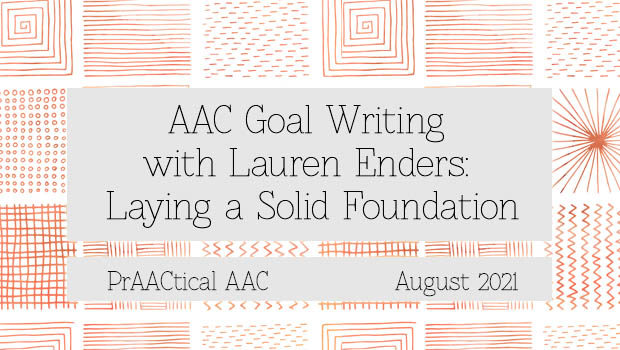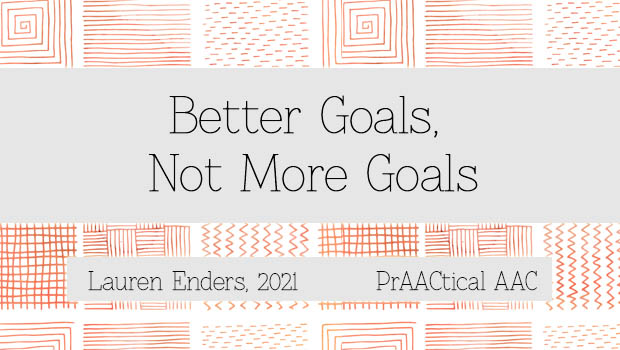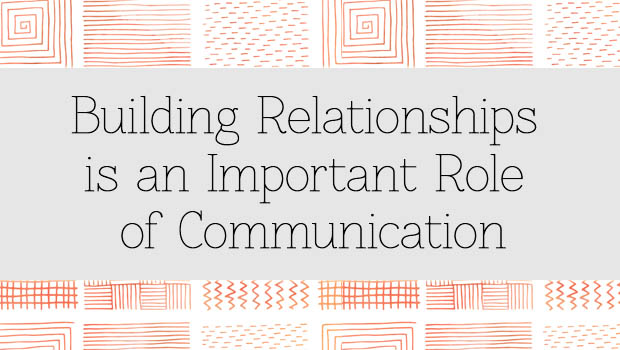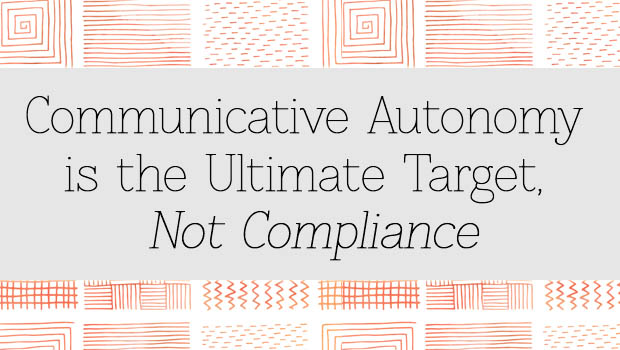AAC Goal Writing with Lauren Enders: Laying a Solid Foundation

 Writing goals for AAC learners, whether they are beginning communicators or focusing on more advanced linguistic concepts, can be tricky and intimidating. Today, we introduce a new series authored by PrAACtical AAC friend and AAC/AT expert Lauren Enders to give us insight on the process and tips for developing strong goals and objectives. Throughout this series, Lauren shares her perspective developed from her years of experience in public schools and as a nationally recognized presenter.
Writing goals for AAC learners, whether they are beginning communicators or focusing on more advanced linguistic concepts, can be tricky and intimidating. Today, we introduce a new series authored by PrAACtical AAC friend and AAC/AT expert Lauren Enders to give us insight on the process and tips for developing strong goals and objectives. Throughout this series, Lauren shares her perspective developed from her years of experience in public schools and as a nationally recognized presenter.
::::::::::::::::::::::::::::::::::::::::::::::::::::::::::::::::::::::::::::::::::::::::::::
Though it may be hard to believe, back-to-school is around the corner! As we get ready to head back into the classroom, now seems like the perfect time to launch a series exploring best practices to consider when writing IEPs for our AAC learners.
The thought of crafting IEP goals and objectives for students who are learning to use AAC strikes fear into the hearts of many SLPs, special education teachers, and other school IEP team members. Similarly, the IEP process can be stressful for families who want the best for their children but feel they lack the knowledge to play an effective role in the process. In this series of posts, we hope to not only acknowledge that the IEP process is tough, yet doable, but also provide tools, resources, and processes that you can use right away. Upcoming posts will explore:
- Common AAC Goal Writing Challenges and How We Can Overcome those Challenges
- AAC Competencies and Their Role in Goal Creation
- Tools and Processes to Support Goal Development
- Writing Measurable Goals and Collecting Data
- Identifying Team Roles and Responsibilities
It seems fitting to kick off our series on this challenging topic with a set of important acknowledgments and considerations related to developing IEPs for AAC learners.
3 ACKNOWLEDGMENTS
- If you are frustrated by AAC goal writing, you are not alone! Writing IEP goals and objectives for any skill is no easy task. When you must also ensure that AAC learning is properly addressed in the IEP, it can make the task seem even more overwhelming. It’s important to know that anxiety you may experience surrounding IEP development for AAC learners is not only common but shared by both novices and seasoned professionals around the world.
- You are juggling a LOT! We also want to acknowledge that IEP creation is far from the only task on an educator or parent’s plate. We know that trying to ensure that you are doing all you can to support a young learner with complex communication needs is multi-faceted and can be stressful and exhausting. It is our hope that the tools and suggestions we share in this series will answer some of your questions and provide tools, examples, and guidance that will reduce some of that stress!

- You CAN do this! Though we agree that selecting skill targets and writing IEP goals and objectives can be challenging, we want to cheer you on and share that we KNOW you can do this! You were not born knowing how to write IEP goals for AAC learners (and probably didn’t learn in school either), but with some guidance and practice, you will get the hang of it!
3 IMPORTANT CONSIDERATIONS
- Building Relationships is an Important Role of Communication
Before we can think about goals for our students learning to use AAC, we should consider a crucial but often overlooked role of communication…building relationships. Chris Klein, who has used AAC throughout his lifetime said, “The goal of AAC should be to say anything that you want to say. It isn’t about telling a person what you need and/or want. It’s about becoming an effective communicator, so you can build relationships. Building relationships helps you to network, which helps you to become anything that you want to become.” Keeping this essential goal in mind as you select tasks and draft goals can be useful and help prevent selection of goals that seem to make sense, but don’t end up being as meaningful as you hoped. (Chris Klein, 2017)
- Communicative Autonomy is the Ultimate Target, Not Compliance
Throughout this series, you will see frequent references to a groundbreaking resource created and generously shared with the community by Gayle Porter and Linda Burkhart. Writing IEP Goals and Objectives for Receptive and Expressive Communication for Children with Complex Communication Needs, By Linda Burkhart & Gayle Porter from the PODD Communication Books Advanced workshop Manual ©.2019, If you haven’t downloaded, this resource, you might want to do so today!
In this resource, Linda and Gayle ask us to remember the intent of communication. “When writing goals and objectives, it is important to begin with the understanding that expressive communication is a function of the child’s intent. It depends upon the child’s ability to communicate an autonomous message. In other words, the purpose of communication ability is to enable an individual to say what they want to.” Thought-provoking, right? It is so important that we don’t inadvertently view communication under the lens of compliance. Gayle and Linda further explained, “A goal which requires a child to comment, ask a question or request at a specific time may in fact lead to practices which reinforce the child’s concept that communication is a meaningless task, rather than a ‘powerful personal tool I can use to communicate my own messages” (Burkhart & Porter, 2019).

- More is not always better.
When considering the needs of children with complex communication needs, there are many communication skills to be taught and learned. While it’s important to teach a broad range of communication functions and a wide variety of skills, creating too many goals can make it very difficult to monitor progress on any one of those goals. A few well-written goals that can be used to assess a student’s progress accurately over time are better than a slew of less meaningful goals that can be challenging to monitor.
If you are eager to learn more about the art of writing meaningful and effective IEP goals and objectives for AAC learners, stay tuned for the next installment in this series!
::::::::::::::::::::::::::::::::::::::::::::::::::::::::::::::::::::::::::::::::::::::::::::
About the Guest Author
You can learn more from Lauren here.
Lauren S. Enders, MA, CCC-SLP is a licensed and ASHA certified Speech-Language Pathologist working as a school-based Augmentative and Alternative Communication and Assistive Technology (AT) Consultant for Bucks County Intermediate Unit in Bucks County, Pennsylvania. She has had a passion for using AAC and other forms of assistive technology to support students with complex communication needs and complex bodies since she began her career in 1995. Lauren presents regularly at national conferences including Closing the Gap, ATIA, and ASHA as well as more intimate conferences, speaking engagements, and webinars. She has shared her knowledge via blog posts on PrAACticalAAC.org and USSAAC’s Speak Up blog as well as articles published in the ASHA Leader and Closing the Gap Solutions Magazines. Lauren enjoys sharing AAC and AT-related resources and networking with others in the field via Facebook, Pinterest, Twitter, Instagram, and Scoop.It.
Filed under: Featured Posts, PrAACtical Thinking
This post was written by Carole Zangari


